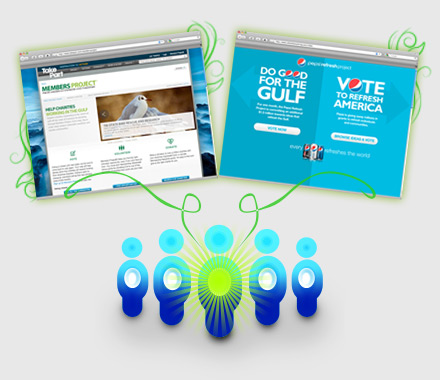Feeding the Moral Hunger: Strategic Social Marketing for the Greater Good?
A trend our team has witnessed for the past nine months is the growing prevalence of cause-related marketing efforts from financial services institutions. A recent article on Slate.com focuses on American Express’s most recent “dogooder” initiative, the American Express Members Project.
Without question, these efforts are in part attempts by banks and other financial institutions to generate some goodwill after being publicly flayed by consumers, the press, the federal government, state governments and on and on. But it is also related to what Katherine Fulton, president of the Monitor Institute, labels “Moral Hunger,” a nationwide uptick in empathy summed up this way by our own Paige Fleury:
What was a society of consumption, collection and live-for-today is now a more pragmatic, empathetic and forward-looking group whose behaviors from spending and saving to brand choice and outlook add up to a new moral hunger – a desire to do good.
But a question has been raised: Are the financial institutions that launch these cause-related marketing efforts being exploitative if they associate themselves with a cause for a fixed period of time to turn a profit? Constance Casey, the author of the Slate.com article concludes: if everyone wins, what’s the harm?
 Sponsorships of course are as old as business itself. Companies and institutions have long given dollars to have their names attached to community events and good causes, or support and promote the volunteer efforts of their employees.
Sponsorships of course are as old as business itself. Companies and institutions have long given dollars to have their names attached to community events and good causes, or support and promote the volunteer efforts of their employees.
What has changed is the weight of cause marketing relative to an organization’s overall marketing budget? The AMEX Members Project is one of the company’s key marketing initiatives… The reason for the change can be summed up in two words: social media. And we think the answer to the question of whether a particular cause-related program is exploitative or not lies in its level of “sociability.”
Let’s compare the AMEX Members Project to the similar Pepsi Refresh Project.
(We can put aside the fact that the first is for a financial services company and the second for a consumer brand, as all these “projects” are intended to appeal to the general public.)
Both The AMEX Members Project and the Pepsi Refresh Project ask the public to submit suggestions for causes they feel should be funded. Proponents are encouraged to promote their causes through their own social media channels. The public is asked to vote. And the causes that get the most votes get a donation. But there is a subtle, and we think important, difference between these two initiatives.
The Pepsi Refresh Project simply sponsors a “cause marketplace.” It has set up categories. But critically, the content of that marketplace is entirely user-generated. The brand is there merely to manage the process. Pepsi doesn’t suggest, explicitly anyway, that it is like any of the causes it sponsors, only that it is like us in that it shares our “Moral Hunger.”
The AMEX Members Project on the other hand explicitly entangles the brand with the causes submitted to its website. AMEX’s kickoff video for example featured two causes promoted by individuals who just happened to be “cardmembers since …” Further, AMEX selects causes with “good optics” to feature on its Project home page.
Can we draw a line between these two initiatives? We think so.
Social media is driving cause-related marketing. But for social to be really social, the forum in which people socialize needs to be under their control, and not dominated by an individual or sponsoring institution. Otherwise, participants will begin to feel that they are not part of a cause, but instead part of “a crummy commercial.”
In social media, we may have found the goose that lays the golden egg. Hopefully us marketers won’t kill it by forcing it to lay more than it naturally can.
For ideas on how all this relates to financial service marketing, see Media Logic’s latest whitepaper, Fear not! How financial service institutions can put the “Big 6” social marketing strategies to work.




